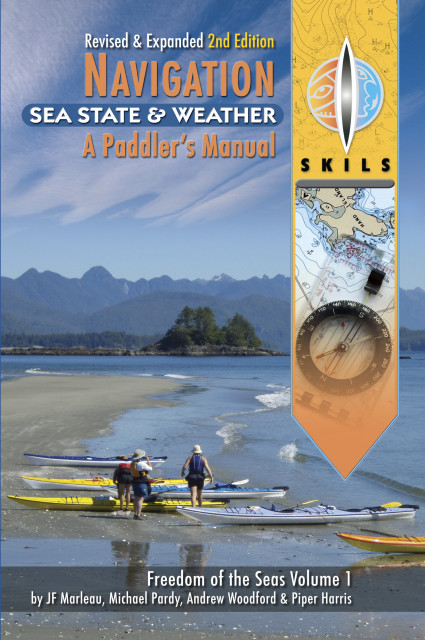

Navigation, Sea State, Weather -A Paddler's Manual. Freedom of the Seas Volume 1. 2020. 288 Pages. Second Edition. Ebook version.
By JF Marleau, Michael Pardy, Andrew Woodford and Piper Harris
Paddlers journey along the boundaries between sea, air and land. Volume 1 of the Freedom of the Seas series contains an important slice of paddling knowledge regarding these boundaries and information about navigation, sea state and weather. We have combined these three knowledge sets into one book for a simple reason: on the water, they are inseparable. Freedom of the Seas, Volume 1 is intended as a reference for kayakers and canoeists touring large bodies of water. This book is written from a Canadian perspective. The examples in this book are drawn from across Canada, but the lessons can be applied anywhere in the world. Ten years after the release of the first edition, we are excited to release this revised and expanded second edition with up-to-date information, new drawings and graphics, and tips to improve your skills and knowledge. We are grateful for some fantastic feedback from SKILS staff and students on how to improve the content and make it easier to understand some complex theoretical concepts. Your ebook will be protected by a password.
What you'll learn in the navigation section:
1) How to read and use a marine chart. The lessons will focus on
The difference between charts and maps
Topographic map symbols
Chart projection
Latitude and longitude
Scale
Measuring distances
Reporting your position
Marine chart symbols
Depths and depth contours
Heights and height contours
The intertidal zone
Hazard symbols
Special areas and boundaries
Aids to navigation
2) Practical navigation techniques. The lesson will focus on
Basic piloting
Effect of wind on speed
Checkpoints
Handrailing
Backstops
Aiming off
Range and line of position
The narrative of navigation
The circles of possibility
3) Advanced practical navigation techniques. The lessons will focus on
Vectors and calculating the effects of currents on speed
Rule of 60 and the small angle rule
Tools for judging distance
4) Collision Regulations. The lessons will focus on
The 3R’s for avoiding a collision
Navigation Lights
Canadian collision regulations
Vessel Traffic Services
Ships whistles and horns
5) Navigating with a compass and electronic navigation. The lessons will focus on
The marine compass
The orienteering compass
True, grid and magnetic north
The variation, declination and deviation
The magnetic dip
Bearing, heading and course
How to use the compass
Bisects and triangulation
Dead reckoning with a compass
Navigation tips to be efficient
Tactics in low visibility, especially in fog or at night
Electronic Navigation
What you'll learn in the sea state section:
1) A better understanding of the how swell and waves are formed and how they affect watercraft. The lessons will focus on
The Beaufort Scale
Rebounding waves
Refracting and diffracting waves
Boomers
Clapotis
Storm Surge
Seiche Waves
Tsunami
Surf
2) A better understanding of how to paddle in the ice. More specifically, you will learn
The different types of iceThe hazards caused by icebergs and glaciers
3) A better understanding of tides and currents, their origin and how they impact watercraft. The lessons will focus on
Variables affecting the tides
Types of currents
Surface features of a current
Paddling in currents
Where to get information about tides and currents
Calculating tide heights and times
Rule of 12ths
Rule of 50/90
Doug and Mike’s most excellent rule of 25%
Calculating current speed, direction and times with maximum rates
Calculating current speed, direction and times with percentage rates
Calculating current speed, direction and times with interpolation
Rule of Thirds
Slack Water Rule
What you'll learn in the weather section:
1) A better understanding of the how weather systems are formed and affect you. The lessons will focus on
Barometric pressure
Clouds
Cells
Jet streams
Air masses
High pressure systems
Low pressure systems
Frontal systems
Precipitation
Wind speed
Wind direction
Coriolis effect
Buys ballot and the cross winds rule
Gap winds
Corner winds
Lee effects
Fog
Sea breezes and land breezes
Katabatic and anabatic winds
Waterspouts
Thunderstorms and lightning
Regional patterns across Canada
2) You’ll develop skills and knowledge how to record and interpret marine weather. The lessons will focus on
Developing competency in recording the marine weather forecast on the VHF radio
Understanding the different type of information broadcasted
Learning essential tips
Developing a shorthand
Reading synoptic weather charts
Great resources for interpreting weather
How to make predictions and decisions